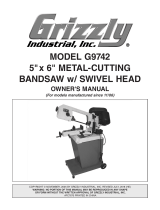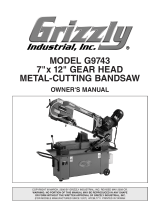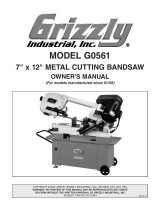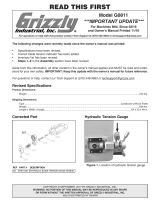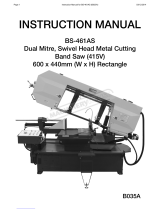Page is loading ...

MODEL G0717
9" x 16"
METAL CUTTING BANDSAW
OWNER'S MANUAL
WARNING: NO PORTION OF THIS MANUAL MAY BE REPRODUCED IN ANY SHAPE
OR FORM WITHOUT THE WRITTEN APPROVAL OF GRIZZLY INDUSTRIAL, INC.

This manual provides critical safety instructions on the proper setup,
operation, maintenance, and service of this machine/tool. Save this
document, refer to it often, and use it to instruct other operators.
Failure to read, understand and follow the instructions in this manual
may result in fire or serious personal injury—including amputation,
electrocution, or death.
The owner of this machine/tool is solely responsible for its safe use.
This responsibility includes but is not limited to proper installation in
a safe environment, personnel training and usage authorization,
proper inspection and maintenance, manual availability and compre-
hension, application of safety devices, cutting/sanding/grinding tool
integrity, and the usage of personal protective equipment.
The manufacturer will not be held liable for injury or property damage
from negligence, improper training, machine modifications or misuse.
Some dust created by power sanding, sawing, grinding, drilling, and
other construction activities contains chemicals known to the State
of California to cause cancer, birth defects or other reproductive
harm. Some examples of these chemicals are:
• Lead from lead-based paints.
• Crystalline silica from bricks, cement and other masonry products.
• Arsenic and chromium from chemically-treated lumber.
Your risk from these exposures varies, depending on how often you
do this type of work. To reduce your exposure to these chemicals:
Work in a well ventilated area, and work with approved safety equip-
ment, such as those dust masks that are specially designed to filter
out microscopic particles.

Table of Contents
INTRODUCTION ............................................... 2
SECTION 1: SAFETY ....................................... 6
SECTION 2: POWER SUPPLY ........................ 9
SECTION 3: SETUP ....................................... 11
SECTION 4: OPERATIONS ........................... 22
SECTION 5: ACCESSORIES ......................... 37
SECTION 6: MAINTENANCE ......................... 39
SECTION 7: SERVICE ................................... 41
SECTION 8: WIRING ...................................... 44
SECTION 9: PARTS ....................................... 48
WARRANTY & RETURNS ............................. 57

INTRODUCTION
Machine Description
We are proud to offer this manual with your new
machine! We've made every effort to be exact
with the instructions, specifications, drawings,
and photographs of the machine we used when
writing this manual. However, sometimes we still
make an occasional mistake.
Also, owing to our policy of continuous improve-
ment, your machine may not exactly match the
manual. If you find this to be the case, and the dif-
ference between the manual and machine leaves
you in doubt, check our website for the latest
manual update or call technical support for help.
Before calling, find the manufacture date of your
machine by looking at the date stamped into the
machine ID label (see below). This will help us
determine if the manual version you received
matches the manufacture date of your machine.
For your convenience, we post all available man-
uals and manual updates for free on our website
at www.grizzly.com. Any updates to your model
of machine will be reflected in these documents
as soon as they are complete.
Manufacture Date
of Your Machine
Manual Accuracy
We stand behind our machines. If you have
any questions or need help, use the information
below to contact us. Before contacting, please get
the serial number and manufacture date of your
machine. This will help us help you faster.
Grizzly Technical Support
1203 Lycoming Mall Circle
Muncy, PA 17756
Phone: (570) 546-9663
Email: [email protected]
We want your feedback on this manual. What did
you like about it? Where could it be improved?
Please take a few minutes to give us feedback.
Grizzly Documentation Manager
P.O. Box 2069
Bellingham, WA 98227-2069
Email: [email protected]
Contact Info

Figure 3.
A.
B.
C.
D.
E.
F.
G.
H.
I.
Identification
J.
K.
L.
M.
N.
O.
P.
Q.

The information contained herein is deemed accurate as of 6/20/2011 and represents our most recent product specifications.
Due to our ongoing improvement efforts, this information may not accurately describe items previously purchased.
PAGE 1 OF 2Model G0717
MACHINE DATA
SHEET
Customer Service #: (570) 546-9663 · To Order Call: (800) 523-4777 · Fax #: (800) 438-5901
MODEL G0717 9" X 16" METAL CUTTING BANDSAW
Product Dimensions:
Weight.............................................................................................................................................................. 577 lbs.
Width (side-to-side) x Depth (front-to-back) x Height..................................................................... 63-1/2 x 27 x 41 in.
Footprint (Length x Width)............................................................................................................................ 16 x 38 in.
Shipping Dimensions:
Type................................................................................................................................................... Wood Slat Crate
Content........................................................................................................................................................... Machine
Weight.............................................................................................................................................................. 673 lbs.
Length x Width x Height...................................................................................................................... 69 x 30 x 48 in.
Electrical:
Power Requirement.............................................................................................. 110V or 220V, Single-Phase, 60Hz
Prewired Voltage.................................................................................................................................................. 220V
Minimum Circuit Size.......................................................................................................... 20A at 110V, 15A at 220V
Switch......................................................................................................................................... Push Button ON/OFF
Switch Voltage..................................................................................................................................................... 220V
Cord Length............................................................................................................................................................ 7 ft.
Cord Gauge.................................................................................................................................................. 14 Gauge
Plug Included........................................................................................................................................................... No
Recommended Plug/Outlet Type.................................................................... NEMA 5-20 for 110V, or 6-15 for 220V
Motors:
Main
Type.................................................................................................................. TEFC Capacitor Start Induction
Horsepower.......................................................................................................................................... 1-1/2 HP
Voltage.............................................................................................................................................. 110V/220V
Prewired..................................................................................................................................................... 220V
Phase............................................................................................................................................ SIngle-Phase
Amps........................................................................................................................... 14A at 110V, 7A at 220V
Speed................................................................................................................................................ 1725 RPM
Cycle......................................................................................................................................................... 60 Hz
Power Transfer ............................................................................................................................ V-Belt + Gear
Bearings............................................................................................................ 6205ZZ, Shielded & Lubricated
Main Specifications:
Operation Info
Blade Speeds................................................................................................................. 83, 132, 170, 235 FPM
Std. Blade Length.............................................................................................................................. 119-1/2 in.
Machine Data Sheet

The information contained herein is deemed accurate as of 6/20/2011 and represents our most recent product specifications.
Due to our ongoing improvement efforts, this information may not accurately describe items previously purchased.
PAGE 2 OF 2Model G0717
Cutting Capacities
Angle Cuts......................................................................................................................................... 45-90 deg.
Vise Jaw Depth............................................................................................................................. 13-1/4 & 8 in.
Vise Jaw Height................................................................................................................................. 4-15/16 in.
Max. Capacity Rectangular Height at 90 Deg..................................................................................... 15-3/4 in.
Max. Capacity Rectangular Width at 90 Deg......................................................................................... 8-7/8 in.
Max. Capacity Round at 90 Deg............................................................................................................ 8-7/8 in.
Max. Capacity Rectangular Height at 30 Deg..................................................................................... 8-7/16 in.
Max. Capacity Rectangular Width at 30 Deg..................................................................................... 9-13/16 in.
Max. Capacity Round at 30 Deg.......................................................................................................... 8-7/16 in.
Max. Capacity Rectangular Height at 45 Deg....................................................................................... 8-7/8 in.
Max. Capacity Rectangular Width at 45 Deg......................................................................................... 6-1/2 in.
Max. Capacity Round at 45 Deg............................................................................................................ 6-1/2 in.
Construction
Table....................................................................................................................... Precision-Ground Cast Iron
Upper Wheel........................................................................................................................................ Cast Iron
Lower Wheel........................................................................................................................................ Cast Iron
Body........................................................................................................................................................... Steel
Base....................................................................................................................................... Pre-Formed Steel
Stand...................................................................................................................................... Pre-Formed Steel
Wheel Cover........................................................................................................................................ Cast Iron
Paint........................................................................................................................................... Powder Coated
Other
Wheel Size................................................................................................................................................. 13 in.
Blade Guides Upper........................................................................................................................ Ball Bearing
Blade Guides Lower........................................................................................................................ Ball Bearing
Coolant Cap......................................................................................................................................... 5-1/2 gal.
Table Info
Table Size Length................................................................................................................................ 16-7/8 in.
Table Size Width................................................................................................................................. 11-3/8 in.
Floor To Cutting Area Height..................................................................................................................... 25 in.
Other Specifications:
ISO Factory .................................................................................................................................................. ISO 9001
Country Of Origin ............................................................................................................................................. Taiwan
Warranty ........................................................................................................................................................... 1 Year
Serial Number Location ................................................................................................. ID Label on Front of Machine
Assembly Time ........................................................................................................................................... 60 Minutes
Sound Rating ..................................................................................................................................................... 80 dB
Features:
Front side access for blade changes
Blade tension indicator
Flood coolant pump with 2 nozzles
Heavy-duty auto-stop switch
Centralized controls
Hydraulic feed rate controls
Quick set vise
Ball bearing blade guides

For Your Own Safety, Read Instruction
Manual Before Operating this Machine
The purpose of safety symbols is to attract your attention to possible hazardous conditions.
This manual uses a series of symbols and signal words intended to convey the level of impor-
tance of the safety messages. The progression of symbols is described below. Remember that
safety messages by themselves do not eliminate danger and are not a substitute for proper
accident prevention measures.
WEARING PROPER APPAREL. Do not wear
clothing, apparel, or jewelry that can become
entangled in moving parts. Always tie back or
cover long hair. Wear non-slip footwear to avoid
accidental slips which could cause a loss of work-
piece control.
HEARING PROTECTION. Always wear hear-
ing protection when operating or observiing loud
machinery. Extended exposure to this noise
without hearing protection can cause permanent
hearing loss.
MENTAL ALERTNESS. Be mentally alert when
running machinery. Never operate under the
influence of drugs or alcohol, when tired, or when
distracted.
OWNER’S MANUAL. Read and understand
this owner’s manual BEFORE using machine.
Untrained users can be seriously hurt.
EYE PROTECTION. Always wear ANSI-approved
safety glasses or a face shield when operating or
observing machinery to reduce the risk of eye
injury or blindness from flying particles. Everyday
eyeglasses are not approved safety glasses.
HAZARDOUS DUST. Dust created while using
machinery may cause cancer, birth defects, or
long-term respiratory damage. Be aware of dust
hazards associated with each workpiece material,
and always wear a NIOSH-approved respirator to
reduce your risk.
Indicates a potentially hazardous situation which, if not avoided,
MAY result in minor or moderate injury. It may also be used to alert
against unsafe practices.
Indicates a potentially hazardous situation which, if not avoided,
COULD result in death or serious injury.
Indicates an imminently hazardous situation which, if not avoided,
WILL result in death or serious injury.
This symbol is used to alert the user to useful information about
proper operation of the machine.
NOTICE
Safety Instructions for Machinery
SECTION 1: SAFETY

DISCONNECTING POWER SUPPLY.Alwaysdis-
connect machine from power supply before ser-
vicing, adjusting, or changing cutting tools (bits,
blades,cutters, etc.). Make sureswitch is in OFF
positionbeforereconnectingtoavoidanunexpect-
edorunintentionalstart.
APPROVED OPERATION. Untrained operators
can be seriously hurt by machinery. Only allow
trained or properly supervised people to use
machine. When machine is not being used, dis-
connect power, remove switch keys, or lock-out
machinetopreventunauthorizeduse—especially
aroundchildren.Makeworkshopkidproof!
DANGEROUS ENVIRONMENTS. Do not use
machinery in wet or rainy locations, cluttered
areas, around flammables, or in poorly-lit areas.
Keep work area clean, dry, and well-lighted to
minimizeriskofinjury.
ONLY USE AS INTENDED. Only use machine
for its intended purpose. Never modify or alter
machineforapurposenotintendedbythemanu-
facturerorseriousinjurymayresult!
USE RECOMMENDED ACCESSORIES.Consult
thisowner’smanualorthemanufacturerforrec-
ommended accessories. Using improper acces-
sorieswillincreasetheriskofseriousinjury.
CHILDREN & BYSTANDERS. Keep children
andbystandersasafedistanceawayfromwork
area.Stopusingmachineifchildrenorbystand-
ersbecomeadistraction.
REMOVE ADJUSTING TOOLS. Never leave
adjustmenttools,chuckkeys,wrenches,etc.inor
onmachine—especiallynearmovingparts.Verify
removalbeforestarting!
SECURING WORKPIECE. When required, use
clampsorvisestosecureworkpiece.Asecured
workpieceprotectshandsandfreesbothofthem
tooperatethemachine.
FEED DIRECTION.Unlessotherwisenoted,feed
work against the rotation of blades or cutters.
Feedinginthesamedirectionofrotationmaypull
yourhandintothecut.
FORCING MACHINERY.Donotforcemachine.
Itwill do the job saferandbetter at the rate for
whichitwasdesigned.
GUARDS & COVERS. Guards and covers can
protect you from accidental contact with moving
parts or flying debris. Make sure they are prop-
erlyinstalled,undamaged, andworkingcorrectly
beforeusingmachine.
NEVER STAND ON MACHINE.Seriousinjuryor
accidental contact with cutting tool mayoccur if
machineistipped.Machinemaybedamaged.
STABLE MACHINE. Unexpectedmovementdur-
ingoperationsgreatlyincreasestheriskofinjury
and loss of control. Verify machines are stable/
secure and mobile bases (if used) are locked
beforestarting.
AWKWARD POSITIONS. Keep proper footing
andbalanceatalltimeswhenoperatingmachine.
Donotoverreach!Avoidawkwardhandpositions
that make workpiece control difficult or increase
theriskofaccidentalinjury.
UNATTENDED OPERATION. Never leave
machinerunningwhileunattended.Turnmachine
offandensureallmovingpartscompletelystop
beforewalkingaway.
MAINTAIN WITH CARE.Followallmaintenance
instructions and lubrication schedules to keep
machineingoodworkingcondition.Animproperly
maintainedmachinemayincreasetheriskofseri-
ousinjury.
CHECK DAMAGED PARTS. Regularly inspect
machine for damaged parts, loose bolts, mis-
adjusted or mis-aligned parts, binding, or any
other conditions that may affect safe operation.
Alwaysrepairorreplacedamagedormis-adjust-
edpartsbeforeoperatingmachine.
EXPERIENCING DIFFICULTIES. If at any time
you are experiencing difficulties performing the
intended operation, stop using the machine!
Contact our Technical Support Department at
(570)546-9663.

Safety Instructions for Metal Cutting
Bandsaws
FIRE HAZARD.
CUTTING FLUID SAFETY.
ATTENTION TO WORK AREA.
MAINTENANCE/SERVICE.
HEARING PROTECTION & HAZARDS.
HOT SURFACES.
BLADE CONDITION.
HAND PLACEMENT.
ENTANGLEMENT HAZARDS.
BLADE REPLACEMENT.
WORKPIECE HANDLING.
LOSS OF STABILITY.
POWER INTERRUPTION.
No list of safety guidelines can be complete. Every shop environment is different. Like all
machines there is danger associated with the Model G0717. Accidents are frequently caused by
lack of familiarity or failure to pay attention. Use this machine with respect and caution to lessen
the possibility of operator injury. If normal safety precautions are overlooked or ignored, serious
personal injury may occur.

SECTION 2: POWER SUPPLY
Availability
Before installing the machine, consider the avail-
ability and proximity of the required power supply
circuit. If an existing circuit does not meet the
requirements for this machine, a new circuit must
be installed. To minimize the risk of electrocu-
tion, fire, or equipment damage, installation work
and electrical wiring must be done by a qualified
electrician in accordance with all applicable codes
and standards.
Electrocution, fire, or
equipment damage may
occur if machine is not
correctly grounded and
connected to the power
supply.
Full-Load Current Rating
The full-load current rating is the amperage a
machine draws at 100% of the rated output power.
On machines with multiple motors, this is the
amperage drawn by the largest motor or sum of all
motors and electrical devices that might operate
at one time during normal operations.
Full-Load Current Rating at 220V ....... 7 Amps
Full-Load Current Rating at 110V ...... 14 Amps
The full-load current is not the maximum amount
of amps that the machine will draw. If the machine
is overloaded, it will draw additional amps beyond
the full-load rating.
If the machine is overloaded for a sufficient length
of time, damage, overheating, or fire may result—
especially if connected to an undersized circuit.
To reduce the risk of these hazards, avoid over-
loading the machine during operation and make
sure it is connected to a power supply circuit that
meets the requirements in the following section.
For your own safety and protection of
property, consult a qualified electrician if
you are unsure about wiring practices or
electrical codes in your area.
Note: The circuit requirements listed in this man-
ual apply to a dedicated circuit—where only one
machine will be running at a time. If this machine
will be connected to a shared circuit where mul-
tiple machines will be running at the same time,
consult a qualified electrician to ensure that the
circuit is properly sized for safe operation.
A power supply circuit includes all electrical
equipment between the breaker box or fuse panel
in the building and the machine. The power sup-
ply circuit used for this machine must be sized to
safely handle the full-load current drawn from the
machine for an extended period of time. (If this
machine is connected to a circuit protected by
fuses, use a time delay fuse marked D.)
Circuit Information
Circuit Requirements for 220V
This machine is prewired to operate on a 220V
power supply circuit that has a verified ground and
meets the following requirements:
Nominal Voltage .............................. 220V/240V
Cycle ..........................................................60 Hz
Phase ........................................... Single-Phase
Power Supply Circuit ......................... 15 Amps
Plug/Receptacle ............................. NEMA 6-15
Circuit Requirements for 110V
This machine can be converted to operate on a
110V power supply (refer to Voltage Conversion
instructions) that has a verified ground and meets
the following requirements:
Nominal Voltage ............................... 110V/120V
Cycle ..........................................................60 Hz
Phase ........................................... Single-Phase
Power Supply Circuit ......................... 20 Amps
Plug/Receptacle ............................. NEMA 5-20

Improper connection of the equipment-grounding
wire can result in a risk of electric shock. The
wire with green insulation (with or without yellow
stripes) is the equipment-grounding wire. If repair
or replacement of the power cord or plug is nec-
essary, do not connect the equipment-grounding
wire to a live (current carrying) terminal.
Check with a qualified electrician or service per-
sonnel if you do not understand these grounding
requirements, or if you are in doubt about whether
the tool is properly grounded. If you ever notice
that a cord or plug is damaged or worn, discon-
nect it from power, and immediately replace it with
a new one.
Extension Cords
We do not recommend using an extension cord
with this machine. If you must use an extension
cord, only use it if absolutely necessary and only
on a temporary basis.
Extension cords cause voltage drop, which may
damage electrical components and shorten motor
life. Voltage drop increases as the extension cord
size gets longer and the gauge size gets smaller
(higher gauge numbers indicate smaller sizes).
Any extension cord used with this machine must
contain a ground wire, match the required plug
and receptacle, and meet the following require-
ments:
Minimum Gauge Size ...........................12 AWG
Maximum Length (Shorter is Better).......50 ft.
Grounding Requirements
This machine MUST be grounded. In the event
of certain malfunctions or breakdowns, grounding
reduces the risk of electric shock by providing a
path of least resistance for electric current.
Figure 5.
Grounding Prong
Hot
Neutral
5-20 PLUG
GROUNDED
5-20 RECEPTACLE
Figure 4.
Grounding Prong
Current Carrying Prongs
6-15 PLUG
GROUNDED
6-15 RECEPTACLE
For 220V operation: This machine is equipped
with a power cord that has an equipment-ground-
ing wire and a grounding plug (see following fig-
ure). The plug must only be inserted into a match-
ing receptacle (outlet) that is properly installed
and grounded in accordance with all local codes
and ordinances.
For 110V operation: The plug specified under
“Circuit Requirements for 110V” on the previ-
ous page has a grounding prong that must be
attached to the equipment-grounding wire inside
the included power cord. The plug must only be
inserted into a matching receptacle (see below)
that is properly installed and grounded in accor-
dance with all local codes and ordinances.
No adapter should be used with the
provided plug. If the plug does not fit the
available receptacle, or the machine must
be reconnected for use on a different type
of circuit, the reconnection must be made
by a qualified electrician and comply with all
local codes and ordinances.

SECTION 3: SETUP
Description Qty
Needed for Setup
Your machine was carefully packaged for safe
transportation. Remove the packaging materials
from around your machine and inspect it. If you
discover any damage, please call us immediately
at (570) 546-9663 for advice.
Save the containers and all packing materials for
possible inspection by the carrier or its agent.
Otherwise, filing a freight claim can be difficult.
When you are completely satisfied with the condi-
tion of your shipment, inventory the contents.
Unpacking
SUFFOCATION HAZARD!
Keep children and pets away
from plastic bags or packing
materials unpacked with this
machine. Discard immediately.
This machine presents
serious injury hazards
to untrained users. Read
through this entire manual
to become familiar with
the controls and opera-
tions before starting the
machine!
Wear safety glasses dur-
ing the entire setup pro-
cess!
This machine and its com-
ponents are very heavy.
Use power lifting equip-
ment such as a fork lift
or hoist to move heavy
items.

Inventory
The following is a description of the main compo-
nents shipped with your machine. Lay the compo-
nents out to inventory them.
If any non-proprietary parts are missing (e.g. a
nut or a washer), we will gladly replace them; or
for the sake of expediency, replacements can be
obtained at your local hardware store.
Figure 6.
NOTICE
If you cannot find an item on this list, check
the mounting location on the machine or the
packaging materials. Sometimes parts are
pre-installed for shipping, or they become
hidden by packaging materials.
Item (Figure 6) Qty
A.
B.
C.
D.
E.
F.

The unpainted surfaces of your machine are
coated with a heavy-duty rust preventative that
prevents corrosion during shipment and storage.
This rust preventative works extremely well, but it
will take a little time to clean.
Be patient and do a thorough job cleaning your
machine. The time you spend doing this now will
give you a better appreciation for the proper care
of your machine's unpainted surfaces.
There are many ways to remove this rust preven-
tative, but the following steps work well in a wide
variety of situations. Always follow the manufac-
turer’s instructions with any cleaning product you
use and make sure you work in a well-ventilated
area to minimize exposure to toxic fumes.
Before cleaning, gather the following:
• Disposable Rags
• Cleaner/degreaser (WD•40 works well)
• Safety glasses & disposable gloves
• Plastic paint scraper (optional)
Basic steps for removing rust preventative:
1. Put on safety glasses.
2. Coat the rust preventative with a liberal
amount of cleaner/degreaser, then let it soak
for 5–10 minutes.
3. Wipe off the surfaces. If your cleaner/degreas-
er is effective, the rust preventative will wipe
off easily. If you have a plastic paint scraper,
scrape off as much as you can first, then wipe
off the rest with the rag.
4. Repeat Steps 2–3 as necessary until clean,
then coat all unpainted surfaces with a quality
metal protectant to prevent rust.
Gasoline or products
with low flash points can
explode or cause fire if
used to clean machin-
ery. Avoid cleaning with
these products.
Many cleaning solvents
are toxic if concentrat-
ed amounts are inhaled.
Only work in a well-venti-
lated area.
NOTICE
Avoid chlorine-based solvents, such as
acetone or brake parts cleaner, that may
damage painted surfaces. Test all cleaners
in an inconspicuous area before using to
make sure they will not damage paint.
Cleanup

Site Considerations
Figure 7.
30" Minimum
30" Minimum
64"
18.5"
15"
29"
6"
Wall
Wall
Weight Load
Refer to the Machine Data Sheet for the weight
of your machine. Make sure that the surface upon
which the machine is placed will bear the weight
of the machine, additional equipment that may be
installed on the machine, and the heaviest work-
piece that will be used. Additionally, consider the
weight of the operator and any dynamic loading
that may occur when operating the machine.
Space Allocation
Consider the largest size of workpiece that will
be processed through this machine and provide
enough space around the machine for adequate
operator material handling or the installation of
auxiliary equipment. With permanent installations,
leave enough space around the machine to open
or remove doors/covers as required by the main-
tenance and service described in this manual.
See below for required space allocation.
Physical Environment
The physical environment where your machine
is operated is important for safe operation and
the longevity of its components. For best results,
operate this machine in a dry environment that is
free from excessive moisture, hazardous chemi-
cals, airborne abrasives, or extreme conditions.
Extreme conditions for this type of machinery are
generally those where the ambient temperature
range exceeds 41°–104°F; the relative humidity
range exceeds 20–95% (non-condensing); or the
environment is subject to vibration, shocks, or
bumps.
Electrical Installation
Place this machine near an existing power source.
Make sure all power cords are protected from
traffic, material handling, moisture, chemicals,
or other hazards. Make sure to leave access to
a means of disconnecting the power source or
engaging a lockout/tagout device.
Lighting
Lighting around the machine must be adequate
enough that operations can be performed safely.
Shadows, glare, or strobe effects that may distract
or impede the operator must be eliminated.
Children or untrained people
may be seriously injured by
this machine. Only install in an
access restricted location.

Lifting & Placing
The Model G0717 is a
heavy machine. Serious
personal injury may occur
if safe moving methods
are not used. To be safe,
get assistance and use
power equipment to move
the shipping crate and
remove the machine from
the crate.
Figure9
Using Machine Mounts
Figure 9
Bolting to Concrete Floors
Figure 8
Figure 8
Mounting
NOTICE
We strongly recommend securing your
machine to the floor if it is hardwired to the
power source. Consult with your electrician
to ensure compliance with local codes.
NOTICE
Anchor studs are stronger and more per-
manent alternatives to lag shield anchors;
however, they will stick out of the floor,
which may cause a tripping hazard if you
decide to move your machine.
Figure8

Assembly
To assemble your machine:
1.
Figure 10
2.
3. Figure
11, Step 1
4.
Figure12
7.
8. Figure 13
9.
Step 8
10. Step 5V-Belt
Page 43
Figure 13. Motor adjustment bolt.
Figure 11. Attaching control panel.
Figure 10. Remove hex bolts.
Figure 12. Mounting motor.
5.
6.
Step 4Figure12

11.
Figure 14
12.
13. Figure
15
14.
Step 13
Figure 16
Start
Capacitor
400MFD
125VAC
Run
Capacitor
40MFD
250VAC
Hot
Ground
Hot
Cutting Fluid
Pump Motor
1/8HP, 220V
Control Panel
(viewed from behind)
Main Motor 1-1/2HP, 220V
Saw Travel
Limit Switch
6-15 Plug
(Included)
220
VAC
G
Ground
Start
Capacitor
3MFD
450VAC
Ground
1
2
4
4
1
11
1
5
5
3
3
3
3
2
4
4 0
12
1
3
2
2
2
2
V1
V1
U1
U1
V2
U2
4
1
3
2
Cutting Fluid
Pump Switch Emergency Stop Button Start Button ON Lamp
b
b
f
c
c
d
Cutting Fluid
Pump Motor
Rewired for 110V
Ground
Start
Capacitor
3MFD
450VAC
V2
U2
4
1
3
2
e
Run
Capacitor
40MFD
250VAC
Main Motor, Rewired for 110V
Ground
4
1
3
2
V1
V1
U1
U1
Rewired for 110V
Rewired for 110V
d
e
Neutral
Hot
Ground
110 VAC
5-20 Plug
(As Recommended
for 110V)
Rewired for 110V
f
Figure 14. Wiring motor. Figure 16. Mounting belt cover.
Figure 15. Belt cover hardware.

Power Connection
After you have completed all previous setup
instructions and circuit requirements, the machine
is ready to be connected to the power supply.
To avoid unexpected startups or property dam-
age, use the following steps whenever connecting
or disconnecting the machine.
Connecting Power
Figure 17. Connecting power.
1. TurnthemachinepowerswitchOFF.
2. Insert the power cord plug into a matching
power supply receptacle. The machine is
nowconnectedtothepowersource.
Disconnecting Power
Figure 18. Disconnecting power.
1. TurnthemachinepowerswitchOFF.
2. Graspthemoldedplugandpullitcompletely
outofthereceptacle.Donotpullbythecord
asthismaydamagethewiresinside.
NOTICE
The Model G0717 is prewired for 220V. If
you plan to operate the machine at 110V,
the motors must be rewired (see Page 46)
and a 110V plug must be installed.
/
